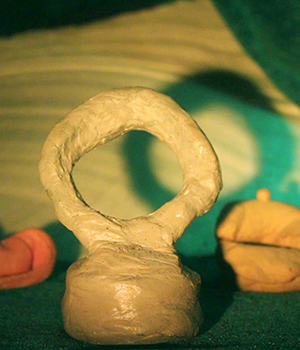I write these lines from my mother’s dementia home. My mother doesn’t know who I am. She has no words for me. To see me is an effort that causes confusion. She knows that she feels, but not what or why. Mother answers: she holds my face in her hands and leans her forehead against mine. We linger in this position, head to head, while she closes her eyes to see better. Feeling, action, visualisation, thought transference.
One of many exciting things about art education is its intimate relationship to not knowing. The many entangled ways in which artists do not know what they know, and can all that they cannot, extend art beyond the prevailing paradigm of knowledge. In her work, the philosopher Jonna Bornemark asks a question that resonates in studio conversations with the bachelor’s students of Fine Art: If we do not know everything, how do we notice what is important? What abilities do we use then?
The students answer: We take life into our own hands and make a scythe out of clay. We paint the photographs repeatedly. We install our own pedestrian crossing to understand the traffic and use the colour yellow as a contrast fluid in the concepts of illness and health. We let the White Sea leak amber from cowrie shells. We rub a microphone over hidden inner worlds. We shape with the scent of an ongoing transformation, with a tone in the text, with a twilight of cardboard and lamps and the way in which pastels are both dry and wet. We let the back shine through the front. We build persistently with passion out of materials we happen to find, and we act without conviction to investigate whether conviction is possible.
From these idiosyncratic studies emerge a consciousness and a thinking in motion. A kind of sense that we need a lot of today. What if the unknown is not just an emptiness that must be filled or a defect that should be corrected, but instead an inevitable aspect of everyday life, which constantly renews itself as we continue to feel and interact with the world?
I, Professor and daughter, answer: Studying art is a way to practice the ability to continue to relate vividly to what is important. Even when what is important is an effort causing confusion.
Loulou Cherinet, Professor of Fine Art
I write these lines from my mother’s dementia home. My mother doesn’t know who I am. She has no words for me. To see me is an effort that causes confusion. She knows that she feels, but not what or why. Mother answers: she holds my face in her hands and leans her forehead against mine. We linger in this position, head to head, while she closes her eyes to see better. Feeling, action, visualisation, thought transference.
One of many exciting things about art education is its intimate relationship to not knowing. The many entangled ways in which artists do not know what they know, and can all that they cannot, extend art beyond the prevailing paradigm of knowledge. In her work, the philosopher Jonna Bornemark asks a question that resonates in studio conversations with the bachelor’s students of Fine Art: If we do not know everything, how do we notice what is important? What abilities do we use then?
The students answer: We take life into our own hands and make a scythe out of clay. We paint the photographs repeatedly. We install our own pedestrian crossing to understand the traffic and use the colour yellow as a contrast fluid in the concepts of illness and health. We let the White Sea leak amber from cowrie shells. We rub a microphone over hidden inner worlds. We shape with the scent of an ongoing transformation, with a tone in the text, with a twilight of cardboard and lamps and the way in which pastels are both dry and wet. We let the back shine through the front. We build persistently with passion out of materials we happen to find, and we act without conviction to investigate whether conviction is possible.
From these idiosyncratic studies emerge a consciousness and a thinking in motion. A kind of sense that we need a lot of today. What if the unknown is not just an emptiness that must be filled or a defect that should be corrected, but instead an inevitable aspect of everyday life, which constantly renews itself as we continue to feel and interact with the world?
I, Professor and daughter, answer: Studying art is a way to practice the ability to continue to relate vividly to what is important. Even when what is important is an effort causing confusion.
Loulou Cherinet, Professor of Fine Art















